Analysis of the Characteristics of Fatal Accidents in the Construction Industry in China Based on Statistical Data
Abstract
1. Introduction
2. Materials and Methods
2.1. Data Collection
2.2. Analysis Design
2.3. Classification of the Accident Level in China
2.4. Differences in and Relationships among Some Safety Terms
2.5. About Some Statistical Indexes
2.6. Relative Indexes for Clustering Analysis
3. Results
3.1. GDP of the Construction Industry in China
3.2. Characteristics of Construction Accidents
3.2.1. Construction Accident Trends by Year
3.2.2. Types of Construction Accidents
3.2.3. Location of Construction Accidents
3.2.4. Region of Construction Accidents
3.3. Characteristics of Major and Severe Accidents
3.3.1. Distribution of Major and Severe Accidents by Year
3.3.2. Types of Major and Severe Accidents
3.3.3. Distribution of Major and Severe Accidents by Month
3.3.4. Distribution of Major and Severe Accidents by Day of the Week
3.3.5. Severe Accidents
3.4. Prediction of Construction Deaths
4. Discussion
4.1. Compared with Previous Studies
4.2. Implications
4.3. Limitations
5. Conclusions
Supplementary Materials
Author Contributions
Funding
Institutional Review Board Statement
Informed Consent Statement
Data Availability Statement
Conflicts of Interest
References
- National Bureau of Statistics. 2020. Available online: http://www.stats.gov.cn/ (accessed on 12 July 2020).
- Fan, J.; Zhang, Y.; Wang, B. The impact of urbanization on residential energy consumption in China: An aggregated and disaggregated analysis. Renew. Sust. Energ. Rev. 2017, 75, 220–233. [Google Scholar] [CrossRef]
- Fung, I.W.H.; Tam, V.W.Y.; Lo, T.Y.; Lu, L.L.H. Developing a risk assessment model for construction safety. Int. J. Proj. Manag. 2010, 28, 593–600. [Google Scholar] [CrossRef]
- Sang, D.C.; Carlson, K. Occupational safety issues in residential construction surveyed in Wisconsin, United States. Ind. Health 2014, 52, 541. [Google Scholar]
- Gangolells, M.; Casals, M.; Forcada, M.; Macarulla, M. Predicting on-site environmental impacts of municipal engineering works. Environ. Impact Assess. Rev. 2014, 44, 43–57. [Google Scholar] [CrossRef]
- Kang, Y.; Siddiqui, S.; Suk, S.J.; Chi, S.; Kim, C. Trends of fall accidents in the U.S. construction industry. J. Constr. Eng. Manag. 2017, 143, 04017043. [Google Scholar] [CrossRef]
- Forteza, F.J.; Carretero-Gomez, J.M.; Sese, A. Occupational risks, accidents on sites and economic performance of construction firms. Saf. Sci. 2017, 94, 61–76. [Google Scholar] [CrossRef]
- Peng, Y.; Zhang, S.; Wu, P. Factors influencing workplace accident costs of building projects. Saf. Sci. 2015, 72, 97–104. [Google Scholar]
- Ministry of Housing and Urban-Rural Development of the People’s Republic of China. 2020. Available online: http://www.mohurd.gov.cn/ (accessed on 30 June 2020).
- Shao, B.; Hu, Z.; Liu, Q.; Chen, S.; He, W. Fatal accident patterns of building construction activities in China. Saf. Sci. 2019, 111, 253–263. [Google Scholar] [CrossRef]
- Dursun, A.E. Statistical analysis of methane explosions in Turkey’s underground coal mines and some recommendations for the prevention of these accidents: 2010–2017. Nat. Hazards 2020, 104, 329–351. [Google Scholar] [CrossRef]
- Ma, C.; Zhou, J.; Yang, D. Causation analysis of hazardous material road transportation accidents based on the ordered logit regression model. Int. J. Environ. Res. Public Health 2020, 17, 1259. [Google Scholar] [CrossRef] [PubMed]
- Jung, S.; Woo, J.; Kang, C. Analysis of severe industrial accidents caused by hazardous chemicals in South Korea from January 2008 to June 2018. Saf. Sci. 2020, 124, 104580. [Google Scholar] [CrossRef]
- Cheng, M.; Kusoemo, D.; Gosno, R.A. Text mining-based construction site accident classification using hybrid supervised machine learning. Autom. Constr. 2020, 118, 103265. [Google Scholar] [CrossRef]
- Ayhan, B.U.; Tokdemir, O.B. Accident analysis for construction safety using latent class clustering and artificial neural networks. J. Constr. Eng. Manag. 2020, 146, 04019114. [Google Scholar] [CrossRef]
- Chan, A.P.C.; Yang, Y.; Darko, A. Construction accidents in a large-scale public infrastructure project: Severity and prevention. J. Constr. Eng. Manag. 2018, 144, 05018010. [Google Scholar] [CrossRef]
- Jin, R.; Wang, F.; Liu, D. Dynamic probabilistic analysis of accidents in construction projects by combining precursor data and expert judgments. Adv. Eng. Inform. 2020, 44, 101062. [Google Scholar] [CrossRef]
- Choi, J.; Gu, B.; Chin, S.; Lee, J.S. Machine learning predictive model based on national data for fatal accidents of construction workers. Autom. Constr. 2020, 110, 102974. [Google Scholar] [CrossRef]
- Kim, J.M.; Son, K.; Yum, S.G.; Ahn, S. Analyzing the risk of safety accidents: The relative risks of migrant workers in construction industry. Sustainability 2020, 12, 5430. [Google Scholar] [CrossRef]
- Chong, H.P.; Low, T.S. Accidents in Malaysian construction industry: Statistical data and court cases. Int. J. Occup. Saf. Ergon. 2014, 20, 503–513. [Google Scholar] [CrossRef]
- Amiri, M.; Ardeshir, A.; Zarandi, M.H.F. Fuzzy probabilistic expert system for occupational hazard assessment in construction. Saf. Sci. 2017, 93, 16–28. [Google Scholar] [CrossRef]
- Lee, Y.C.; Shariatfar, M.; Rashidi, A.; Lee, H.W. Evidence-driven sound detection for prenotification and identification of construction safety hazards and accidents. Autom. Constr. 2020, 113, 103127. [Google Scholar] [CrossRef]
- Dogan, E.; Yurdusev, M.A.; Yildizel, S.A.; Calis, G. Investigation of scaffolding accident in a construction site: A case study analysis. Eng. Fail. Anal. 2021, 120, 105108. [Google Scholar] [CrossRef]
- Zhang, F.; Fleyeh, H.; Wang, X.; Lu, M. Construction site accident analysis using text mining and natural language processing techniques. Autom. Constr. 2019, 99, 238–248. [Google Scholar] [CrossRef]
- Guo, S.; He, J.; Li, J.; Tang, B. Exploring the impact of unsafe behaviors on building construction accidents using a Bayesian network. Int. J. Environ. Res. Public Health 2020, 17, 221. [Google Scholar] [CrossRef] [PubMed]
- Li, K.; Ma, Z.; Robinson, D.; Lin, W.; Li, Z. A data-driven strategy to forecast next-day electricity usage and peak electricity demand of a building portfolio using cluster analysis, cubist regression models and particle swarm optimization. J. Clean. Prod. 2020, 273, 123115. [Google Scholar] [CrossRef]
- Wang, C.; Sun, X.; Shen, L.; Wang, G. Analysis and prediction of influencing parameters on the coal classification performance of a novel three products hydrocyclone screen (TPHS) based on grey system theory. Processes 2020, 8, 974. [Google Scholar] [CrossRef]
- China Statistical Yearbook on Construction. 2020. Available online: https://www.yearbookchina.com/navibooklist-n3018111232-1.html (accessed on 5 July 2020).
- Shao, B.; Hu, Z.; Liu, D. Using improved principal component analysis to explore construction accident situations from the multi-dimensional perspective: A Chinese study. Int. J. Environ. Res. Public Health 2019, 16, 3476. [Google Scholar] [CrossRef] [PubMed]
- Juhari, M.L.; Arifin, K. Validating measurement structure of materials and equipment factors model in the MRT construction industry using confirmatory factor analysis. Saf. Sci. 2020, 131, 104905. [Google Scholar] [CrossRef]
- Rasul, M.; Hosoda, A.; Maekawa, K. Prediction of maximum thermal crack width of RC abutments utilizing actual construction data and study on influential parameters using neural networks. Constr. Build. Mater. 2020, 260, 120477. [Google Scholar] [CrossRef]
- Aguilar, R.; Noel, M.F.; Ramos, L.F. Integration of reverse engineering and non-linear numerical analysis for the seismic assessment of historical adobe buildings. Autom. Constr. 2019, 98, 1–15. [Google Scholar] [CrossRef]
- Ren, R.; Zhou, H.; Hu, Z.; He, S.; Wang, X. Statistical analysis of fire accidents in Chinese highway tunnels 2000–2016. Tunn. Undergr. Space Technol. 2019, 83, 452–460. [Google Scholar] [CrossRef]
- Wang, X.; Meng, F. Statistical analysis of large accidents in China’s coal mines in 2016. Nat. Hazards 2018, 92, 311–325. [Google Scholar] [CrossRef]
- Xu, Q.; Xu, K. Statistical analysis and prediction of fatal accidents in the metallurgical industry in China. Int. J. Environ. Res. Public Health 2020, 17, 3790. [Google Scholar] [CrossRef] [PubMed]
- Gholizadeh, P.; Esmaeili, B. Cost of occupational incidents for electrical contractors: Comparison using robust-factorial analysis of variance. J. Constr. Eng. Manag. 2020, 146, 04020073. [Google Scholar] [CrossRef]
- Cassar, V.; Bezzina, F.; Buttigieg, S. Investigating the psychometric properties and assessment capabilities of the short version of the Health and Safety Executive’s Management Standards Indicator Tool. Int. J. Hum. Resour. Manag. 2020, 31, 2115–2140. [Google Scholar] [CrossRef]
- Xu, Q.; Xu, K.; Yao, X.; Zhang, J. Sand casting safety assessment for foundry enterprises: Fault tree analysis, Heinrich accident triangle, HAZOP-LOPA, bow tie model. R. Soc. Open Sci. 2018, 5, 180915. [Google Scholar] [CrossRef] [PubMed]
- The Central People’s Government of the People’s Republic of China. 2020. Available online: http://www.gov.cn/flfg/2011-04/25/content_1851696.htm (accessed on 18 June 2020).
- Gibb, A.; Lingard, H.; Behm, M.; Cooke, T. Construction accident causality: Learning from different countries and differing consequences. Constr. Manage. Econ. 2014, 32, 446–459. [Google Scholar] [CrossRef]
- Park, I.; Kim, J.; Han, S.; Hyun, C. Analysis of fatal accidents and their causes in the Korean construction industry. Sustainability 2020, 12, 3120. [Google Scholar] [CrossRef]
- Stoltanzadeh, A.; Mohammadfam, I.; Moghimbeygi, A.; Ghiasvand, R. Exploring causal factors on the severity rate of occupational accidents in construction worksites. Int. J. Civ. Eng. 2017, 15, 959–965. [Google Scholar] [CrossRef]
- Lombardi, M.; Fargnoli, M.; Parise, G. Risk profiling from the European statistics on accidents at work accidents’ databases: A case study in construction sites. Int. J. Environ. Res. Public Health 2019, 16, 4748. [Google Scholar] [CrossRef]
- Dumrak, J.; Mostafa, S.; Kamardeen, I.; Rameezdeen, R. Factors associated with the severity of construction accidents: The case of South Australia. Australas. J. Constr. Econ. Build. 2013, 13, 32–49. [Google Scholar] [CrossRef]
- Arquillos, A.L.; Romero, J.C.R.; Gibb, A. Analysis of construction accidents in Spain, 2003–2008. J. Saf. Res. 2012, 43, 381–388. [Google Scholar] [CrossRef] [PubMed]
- Walker, G. Redefining the incidents to learn from: Safety science insights acquired on the journey from black boxes to flight data monitoring. Saf. Sci. 2017, 99, 14–22. [Google Scholar] [CrossRef]
- Moniruzzaman, S.; Andersson, R. Economic development as a determinant of injury mortality—A longitudinal approach. Soc. Sci. Med. 2008, 66, 1699–1708. [Google Scholar] [CrossRef] [PubMed]
- Nees, M.A.; Sharma, N.; Shore, A. Attributions of accidents to “human error” in news stories: Effects on perceived culpability, perceived preventability, and perceived need for punishment. Accid. Anal. Prev. 2020, 148, 105792. [Google Scholar] [CrossRef]
- Anter, A.M.; Ali, M. Feature selection strategy based on hybrid crow search optimization algorithm integrated with chaos theory and fuzzy c-means algorithm for medical diagnosis problems. Soft Comput. 2020, 24, 1565–1584. [Google Scholar] [CrossRef]
- Zhang, J.; Xu, K.; Wang, B.; Wang, R. Synthetic theory model for evolution mechanism of gas explosion accidents. China Saf. Sci. J. 2015, 25, 53–57, (In Chinese with English abstract). [Google Scholar]
- Liu, W.; Zhai, S.H.; Liu, W.L. Predictive analysis of settlement risk in tunnel construction: A bow-tie-bayesian network approach. Adv. Civ. Eng. 2019, 2019, 2045125. [Google Scholar] [CrossRef]
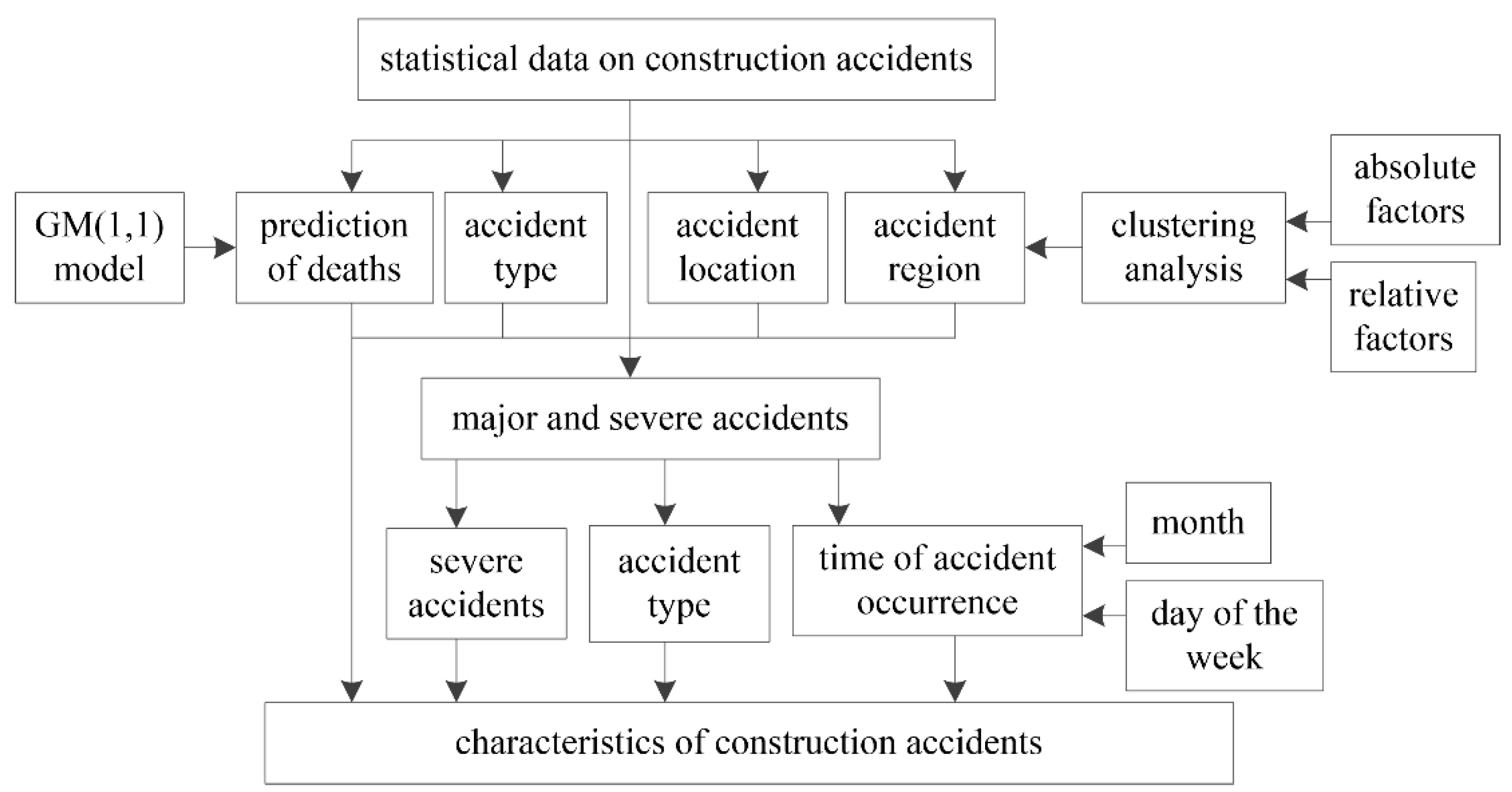
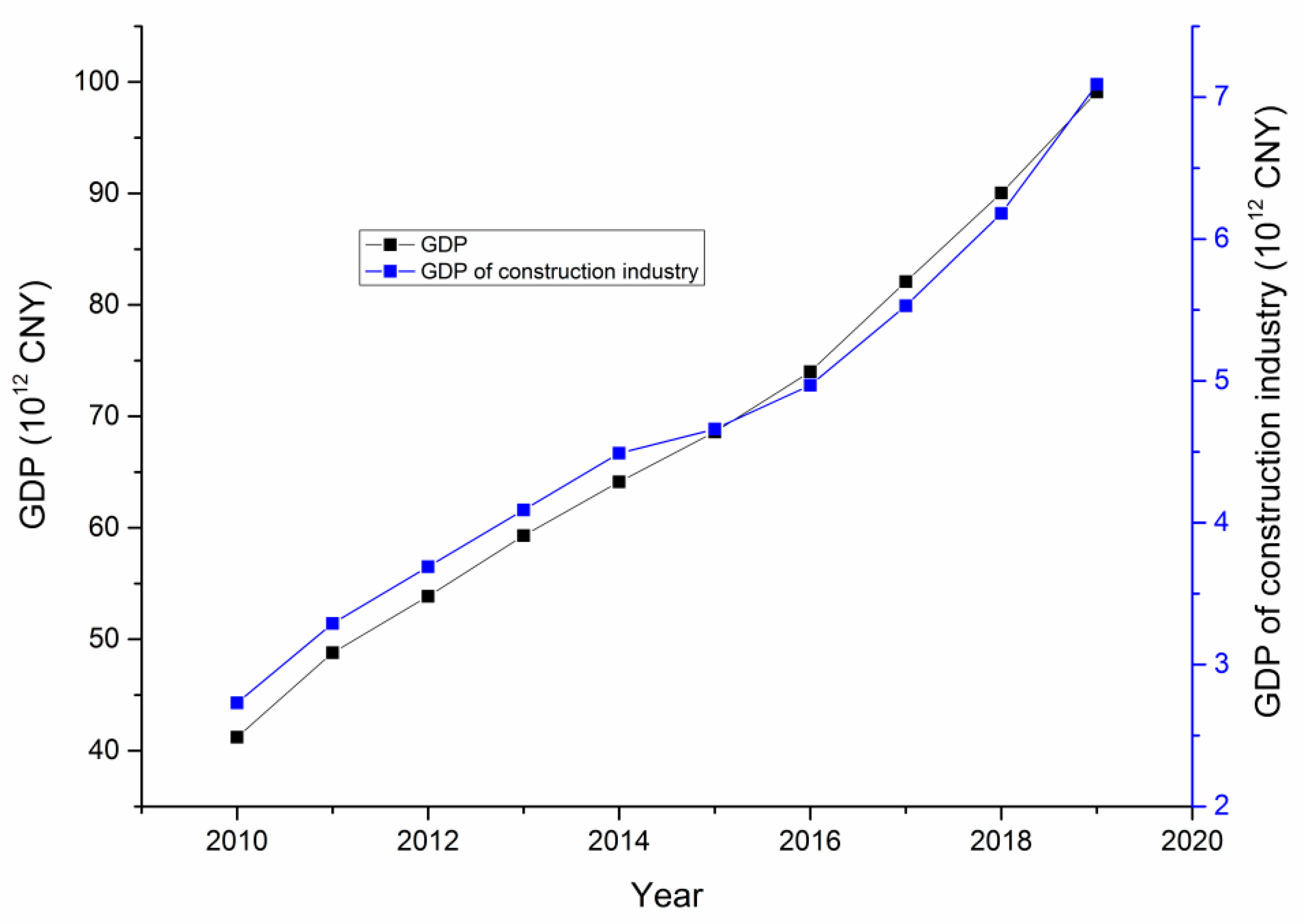
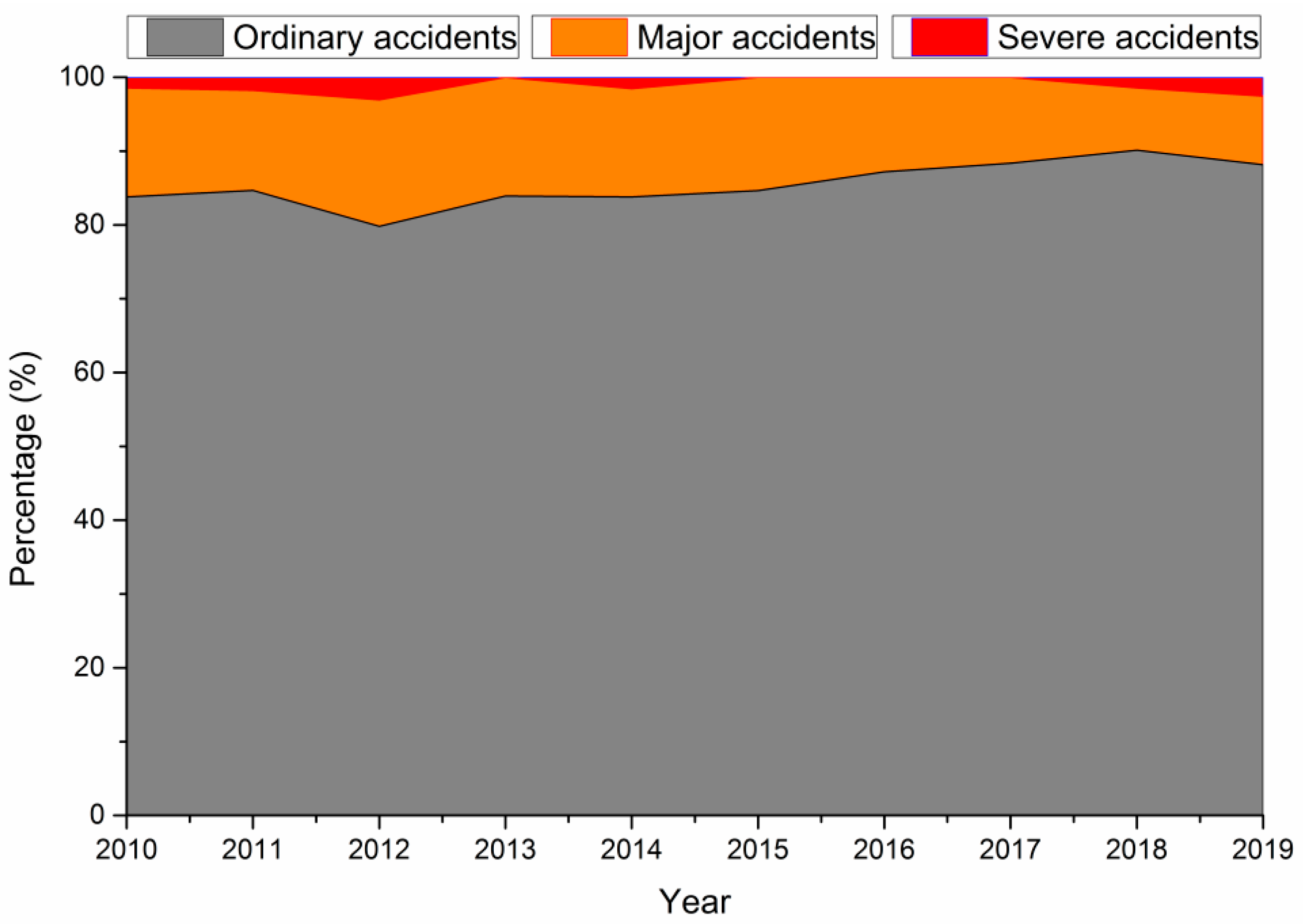
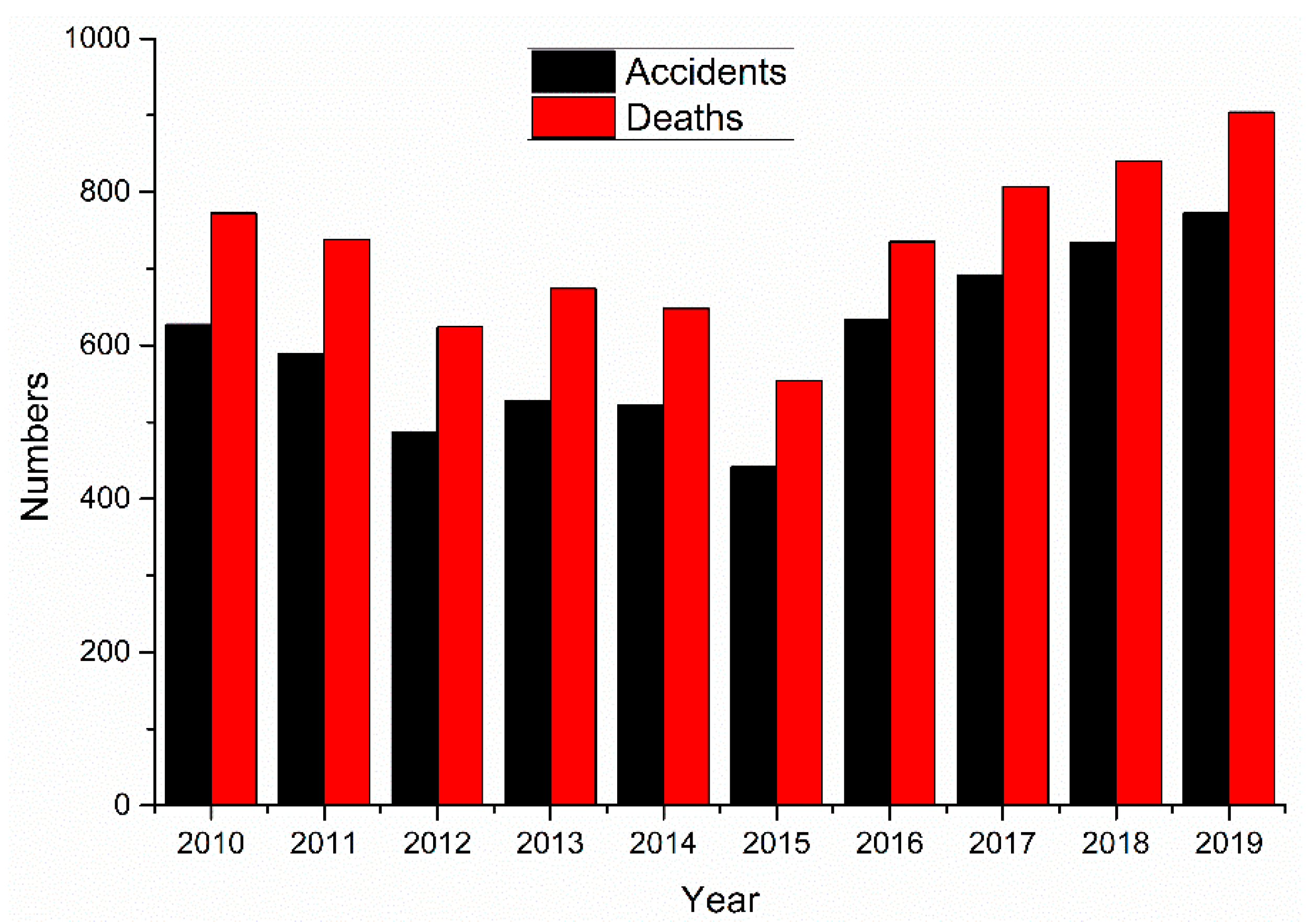
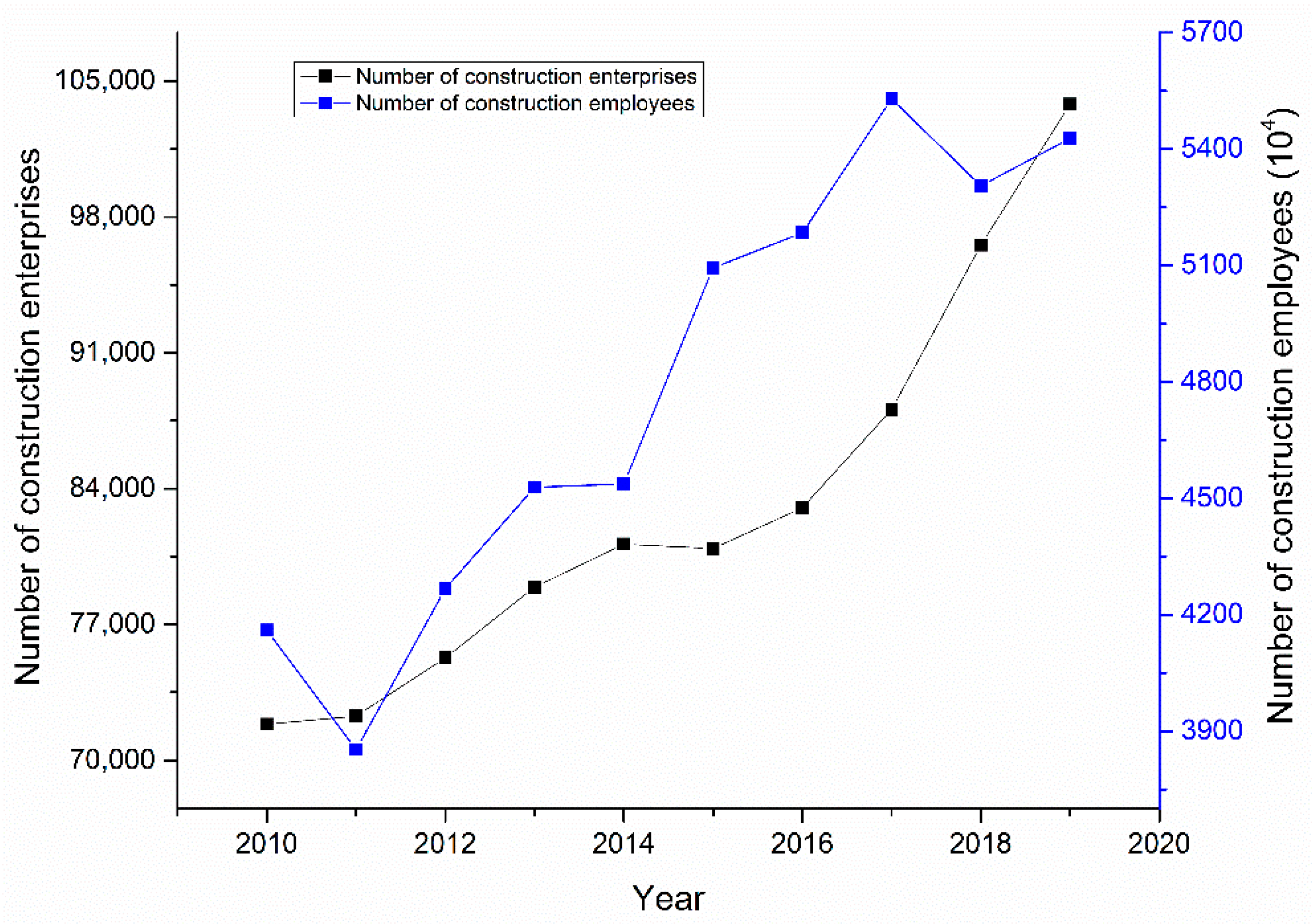
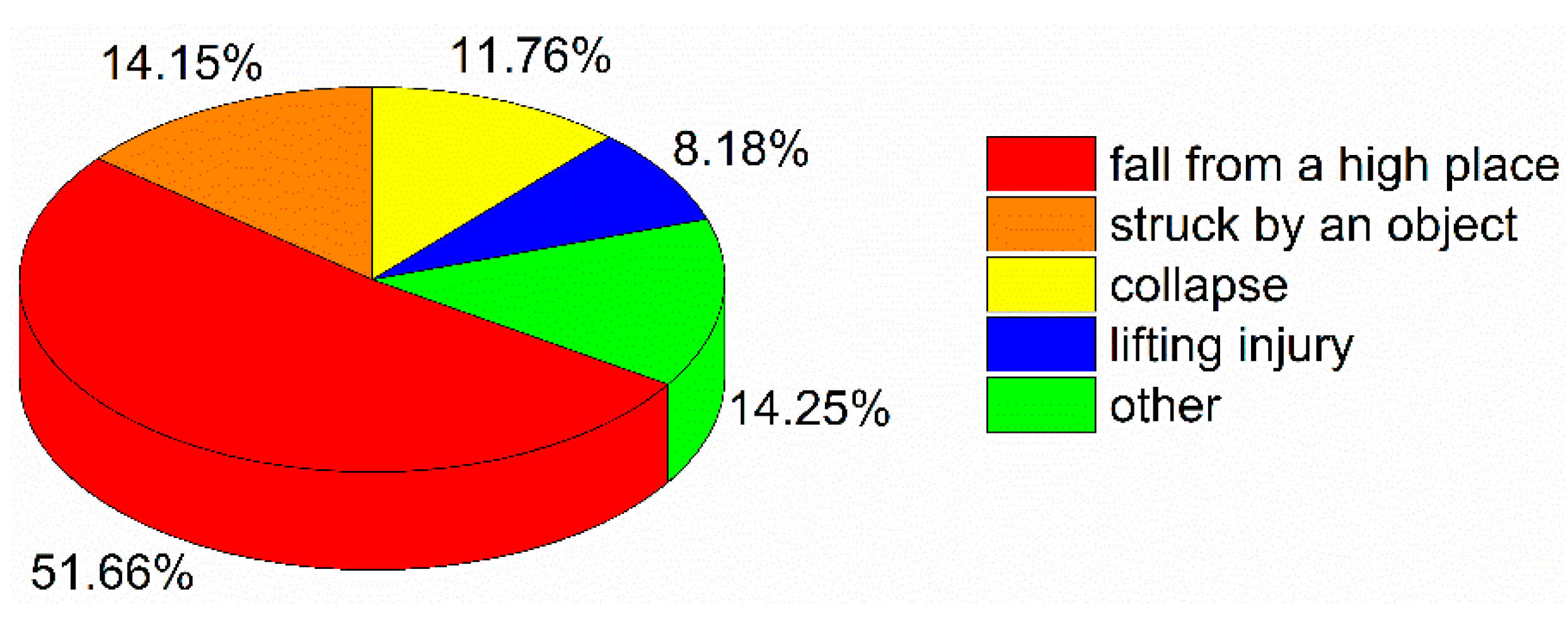
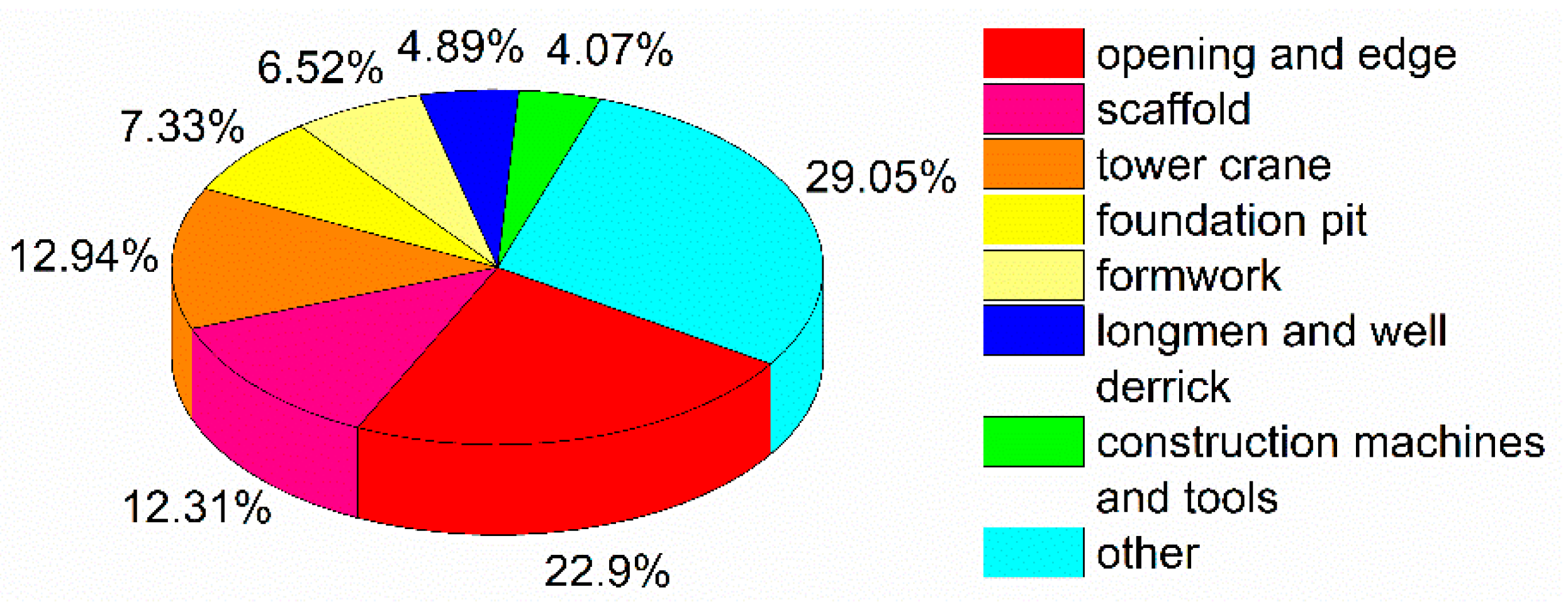

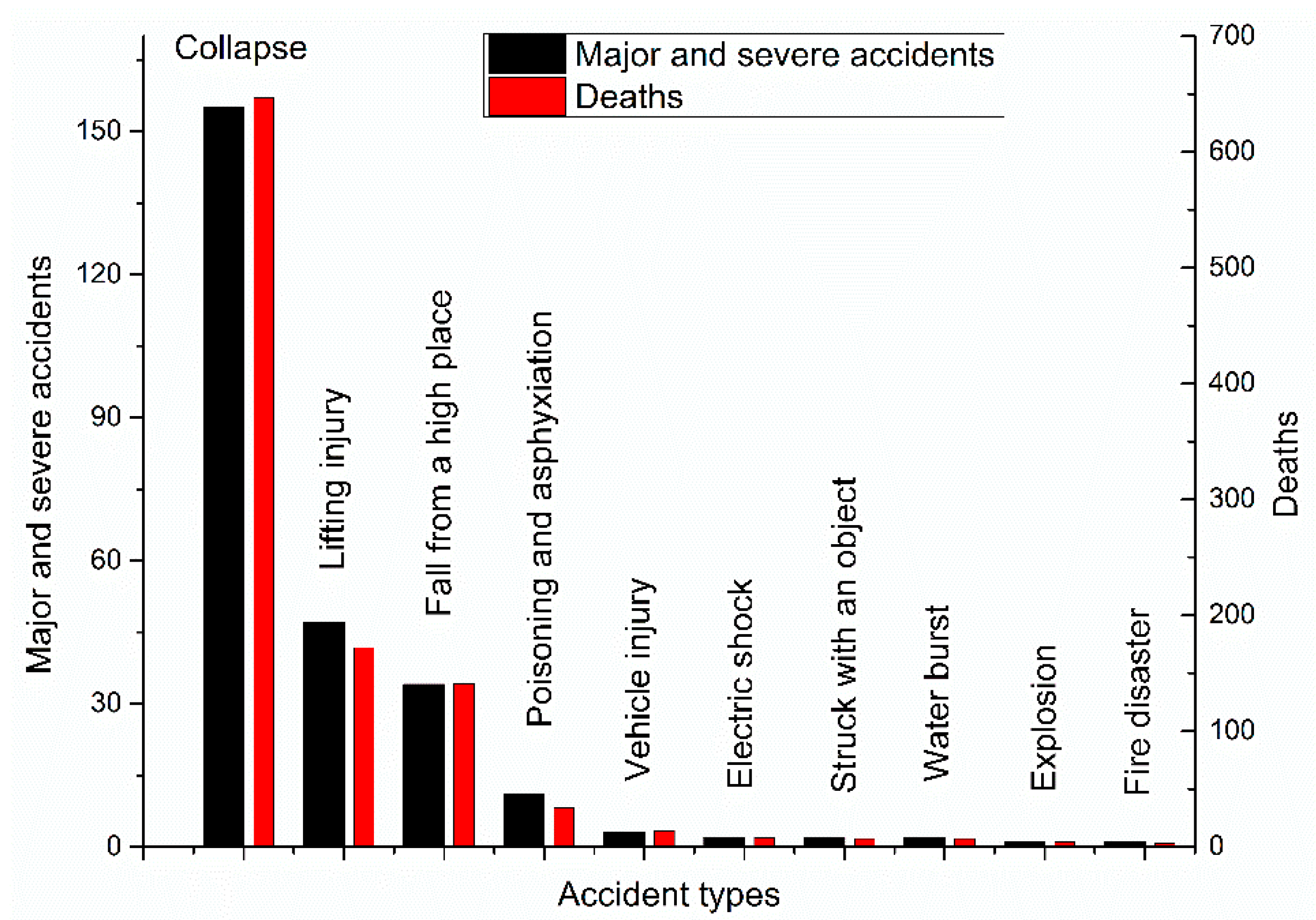

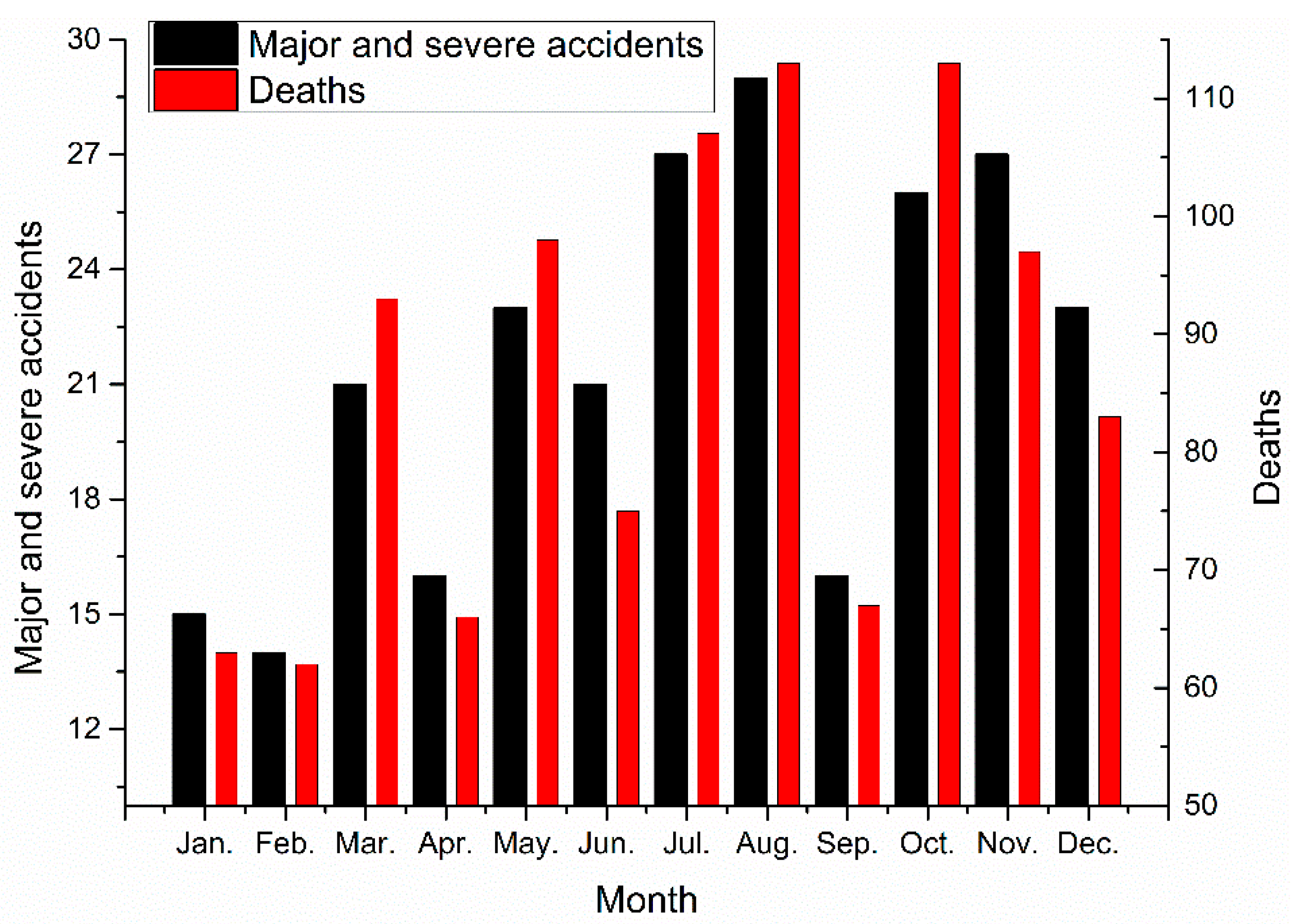
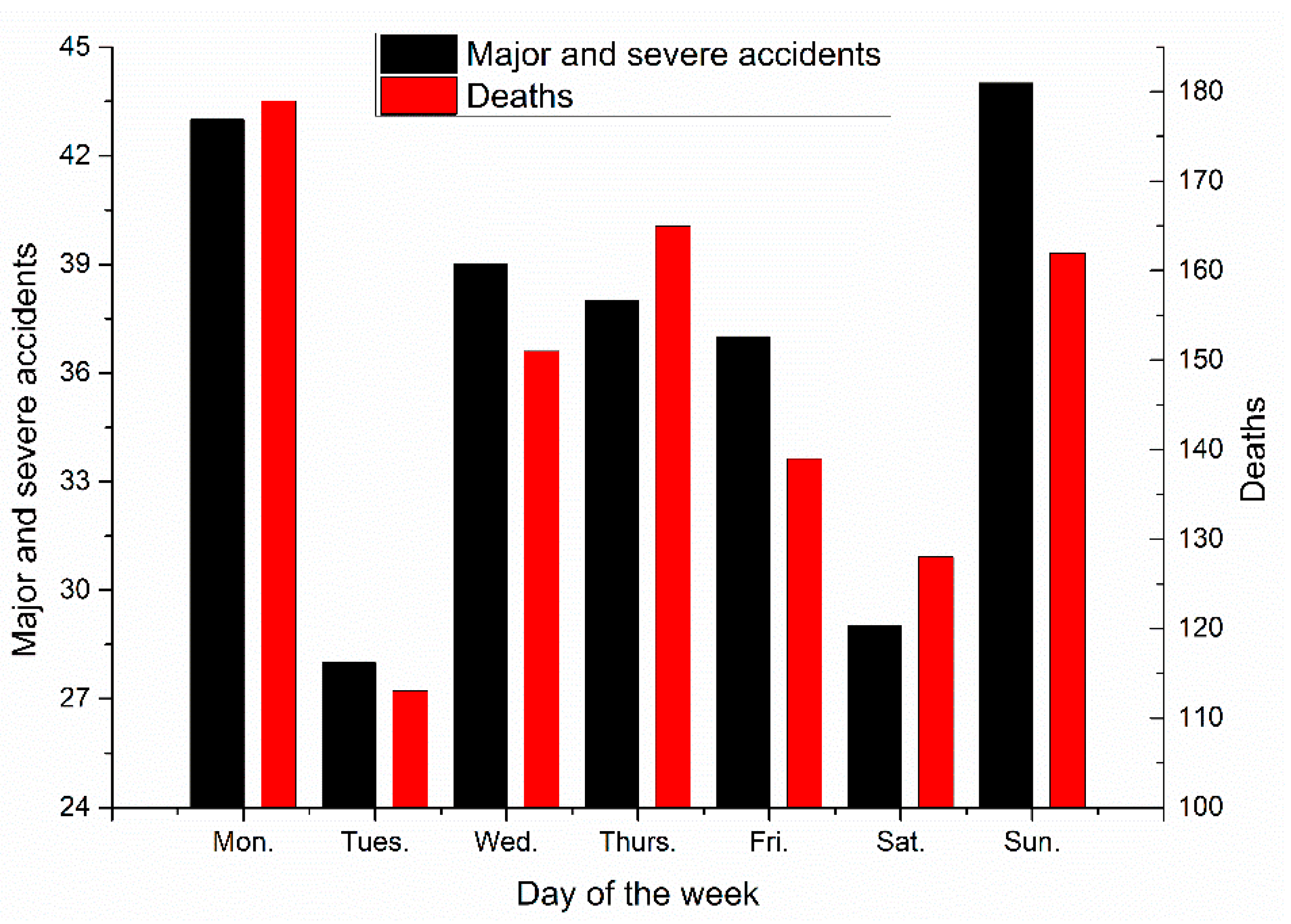
| Independent Variable | Dependent Variable | Variable Type |
|---|---|---|
| Time, including year, month, and day of the week | The number of accidents, deaths, construction enterprises and employees | Global variable |
| Accident type | The number of accidents | Local variable |
| Accident location | The number of accidents | Local variable |
| Accident region | The number of accidents and deaths | Local variable |
| Accident Level | Ordinary | Major | Severe | Extraordinarily Severe |
|---|---|---|---|---|
| Deaths | [0,3) | [3,10) | [10,30) | ≥30 |
| Criteria | Level 1 | Level 2 | Level 3 | Level 4 | Level 5 | Level 6 |
|---|---|---|---|---|---|---|
| Occupational Safety and Health Administration (US) [36] | Fatality | Lost work day or lost time injury | Restricted work injury | Medical treatment injury | First aid | Near miss |
| Health and Safety Executive (UK) [37] | One or more deaths | Three work days lost | Noninjury incidents | |||
| Region | Absolute Factors | Cluster | Relative Factors | Cluster | ||
|---|---|---|---|---|---|---|
| Accidents | Deaths | Death Rate per Unit of Production Value | Death Rate of Staff | |||
| Beijing | 192 | 226 | 3 | 20.66 | 58.25 | 3 |
| Tianjin | 136 | 154 | 3 | 40.74 | 42.42 | 3 |
| Hebei | 90 | 140 | 3 | 24.48 | 14.77 | 3 |
| Shanxi | 61 | 95 | 3 | 23.17 | 13.65 | 3 |
| Inner Mongolia | 125 | 174 | 3 | 162.62 | 70.45 | 2 |
| Liaoning | 118 | 167 | 3 | 45.88 | 28.16 | 3 |
| Jilin | 179 | 214 | 3 | 105.42 | 68.37 | 2 |
| Heilongjiang | 204 | 234 | 3 | 191.80 | 97.10 | 2 |
| Shanghai | 268 | 305 | 2 | 42.90 | 44.08 | 3 |
| Jiangsu | 665 | 749 | 1 | 24.20 | 10.41 | 3 |
| Zhejiang | 354 | 401 | 2 | 19.40 | 6.47 | 3 |
| Anhui | 318 | 377 | 2 | 47.60 | 20.36 | 3 |
| Fujian | 190 | 217 | 3 | 19.02 | 5.53 | 3 |
| Jiangxi | 174 | 214 | 3 | 31.15 | 14.87 | 3 |
| Shandong | 152 | 226 | 3 | 18.93 | 7.84 | 3 |
| Henan | 145 | 213 | 3 | 19.02 | 8.71 | 3 |
| Hubei | 232 | 307 | 2 | 20.22 | 15.06 | 3 |
| Hunan | 167 | 204 | 3 | 21.23 | 8.79 | 3 |
| Guangdong | 363 | 452 | 2 | 32.61 | 19.40 | 3 |
| Guangxi | 213 | 239 | 3 | 54.32 | 20.13 | 3 |
| Hainan | 82 | 91 | 3 | 252.78 | 151.67 | 1 |
| Chongqing | 366 | 390 | 2 | 53.13 | 22.58 | 3 |
| Sichuan | 292 | 341 | 2 | 24.95 | 9.72 | 3 |
| Guizhou | 148 | 208 | 3 | 62.09 | 27.62 | 3 |
| Yunnan | 233 | 271 | 2 | 50.84 | 22.99 | 3 |
| Xizang | 10 | 20 | 3 | 111.11 | 46.51 | 2 |
| Shaanxi | 72 | 96 | 3 | 13.69 | 7.11 | 3 |
| Gansu | 153 | 184 | 3 | 101.66 | 38.74 | 2 |
| Qinghai | 101 | 115 | 3 | 261.36 | 136.90 | 1 |
| Ningxia | 65 | 81 | 3 | 142.11 | 87.10 | 2 |
| Xinjiang | 160 | 191 | 3 | 89.67 | 54.73 | 2 |
| Dependent Factors | Clusters | Errors | F | Sig | ||
|---|---|---|---|---|---|---|
| Mean Square | df | Mean square | df | |||
| Accidents | 198,922.339 | 2 | 2896.036 | 28 | 68.688 | 0 |
| Deaths | 239,088.162 | 2 | 3696.099 | 28 | 64.687 | 0 |
| Dependent Factors | Clustering | Error | F | Sig | ||
|---|---|---|---|---|---|---|
| Mean Square | df | Mean Square | df | |||
| Accidents | 62,881.544 | 2 | 461.383 | 28 | 136.289 | 0 |
| Deaths | 17,834.703 | 2 | 241.183 | 28 | 73.947 | 0 |
| Date | Region | Construction Company | Accident Type | Deaths | Causes |
|---|---|---|---|---|---|
| 16 August 2010 | Jilin | Northeastern Jincheng Construction LLC (Changchun, China) | Lifting injury | 11 | The elevator drive system was running under overload conditions for a long time, causing the motor brake to fail and the construction elevator cage to fall. |
| 8 October 2011 | Liaoning | Dalian Aerbin Group Co., Ltd. (Dalian, China) | Collapse | 13 | While pouring the shear wall, the mold expanded. To repair the expanded mold and remove leaking concrete, the employees dismantled some of the support system rods, which greatly reduced the scaffold’s overall stability and bearing capacity. Additionally, the concrete continued to be poured. Under the load of the concrete being poured and vibrating, the support system could not bear the upper load and became unstable, causing the entire basement roof to collapse. |
| 18 September 2012 | Hubei | Hubei Xianghe Construction Group Co., Ltd. (Wuhan, Hubei) | Fall from a high place | 19 | First, the nuts of the force-bearing bolts on the construction guide rail fell off, making it unable to bear any weight and causing the cage to tip over. Second, the elevator’s safety protection device was damaged. Third, an employee was operating the elevator without a license. Fourth, the employees were overloaded with work. |
| 29 December 2014 | Beijing | Beijing Jiangong First Construction Engineering Co., Ltd. (Beijing, China) | Collapse | 10 | The employees did not stack materials or arrange the split heads according to plan requirements. The split heads and the steel bars did not form a complete structural system, resulting in the foundation slab’s overall collapse. |
| 7 February 2018 | Guangdong | China Transportation Construction Limited Liability Company (Guangzhou, China) | Collapse | 12 | There was a deep water-rich silt layer near a strong, permeable, medium-coarse sand layer at the accident site, and the groundwater was pressure bearing. When the shield tunneling machine passed the site, the risk of permeable sand and mud collapse was high. The sealing at the end of the shield failed during the application. It broke due to the external water and soil pressure, resulting in a permeable channel for water influx. Despite a serious influx of mud and sand, operations were continued in the tunnel, and the evacuation was slow. A great quantity of mud and sand rushed into the tunnel, resulting in a forceful mud–sand flow and an airwave in the narrow space that moved toward the tunnel entrance, trapping and killing some employees. |
| 25 April 2019 | Hebei | Hengshui Guangsha Construction Engineering Co., Ltd. (Hengshui, China) | Fall from a high place | 11 | Two bolts on the west side of the construction lift for the standard section’s connection were not installed. The lifts were put into use without inspection or acceptance checks. |
| 16 May 2019 | Shanghai | Nantong Longyao Construction Engineering Co., Ltd. (Shanghai, China) | Collapse | 12 | A load-bearing wall’s bearing capacity was insufficient, and no measures were adopted to maintain the wall’s stability during the construction process. The load-bearing wall was instantly unstable, and part of the factory structure collapsed in a chain reaction. The employee living area was inside the construction area, causing massive deaths and injuries. |
| Model | Predicting Equation | Correlation Coefficient R2 |
|---|---|---|
| GM(1,1) | x(0)(k+1) = 580.2671e0.0424t | Not applicable |
| Simple linear regression | x = 17.994t + 628.53 | 0.2545 |
| Original Value | GM(1,1) | Simple Linear Regression | ||
|---|---|---|---|---|
| Predicted Number | Relative Error | Predicted Number | Relative Error | |
| 772 | 772 | 0 | 646.524 | 16.25% |
| 738 | 605.466 | 17.96% | 664.518 | 9.96% |
| 624 | 631.693 | 1.23% | 682.512 | 9.38% |
| 653 | 659.056 | 0.93% | 700.506 | 7.28% |
| 648 | 687.604 | 6.11% | 718.5 | 10.88% |
| 554 | 717.388 | 29.49% | 736.494 | 32.94% |
| 735 | 748.46 | 1.83% | 754.488 | 2.65% |
| 807 | 780.884 | 3.24% | 772.482 | 4.28% |
| 840 | 814.709 | 3.01% | 790.476 | 5.9% |
| 904 | 850 | 5.97% | 808.47 | 10.57% |
| Mean relative error | 6.98% | 11.01% | ||
Publisher’s Note: MDPI stays neutral with regard to jurisdictional claims in published maps and institutional affiliations. |
© 2021 by the authors. Licensee MDPI, Basel, Switzerland. This article is an open access article distributed under the terms and conditions of the Creative Commons Attribution (CC BY) license (http://creativecommons.org/licenses/by/4.0/).
Share and Cite
Xu, Q.; Xu, K. Analysis of the Characteristics of Fatal Accidents in the Construction Industry in China Based on Statistical Data. Int. J. Environ. Res. Public Health 2021, 18, 2162. https://doi.org/10.3390/ijerph18042162
Xu Q, Xu K. Analysis of the Characteristics of Fatal Accidents in the Construction Industry in China Based on Statistical Data. International Journal of Environmental Research and Public Health. 2021; 18(4):2162. https://doi.org/10.3390/ijerph18042162
Chicago/Turabian StyleXu, Qingwei, and Kaili Xu. 2021. "Analysis of the Characteristics of Fatal Accidents in the Construction Industry in China Based on Statistical Data" International Journal of Environmental Research and Public Health 18, no. 4: 2162. https://doi.org/10.3390/ijerph18042162
APA StyleXu, Q., & Xu, K. (2021). Analysis of the Characteristics of Fatal Accidents in the Construction Industry in China Based on Statistical Data. International Journal of Environmental Research and Public Health, 18(4), 2162. https://doi.org/10.3390/ijerph18042162







